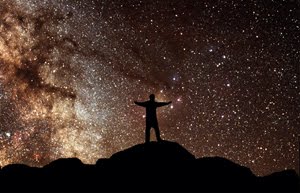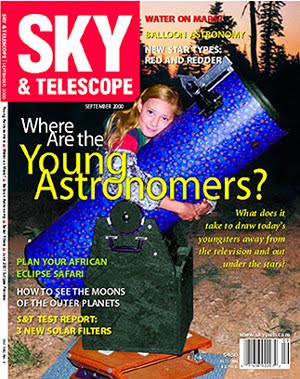On a last minute whim I packed up the truck and headed south at 4:30 p.m. last Friday, January 19th. The sky looked great when I arrived just after sunset from Henry Coe State Park. There was a light breeze from the east, and haze hung over San Jose helping dim the light dome. After dark Marsha Robinson, Bob Czerwinski and Bill Schultz joined me.
I did not have much of an observing program in mind, I am still waiting for the galaxy rich areas of Coma B, Virgo, Canes V and Ursa Major to be better positioned earlier in the evening, so I can continue on the Herschel list I've been working over several observing seasons. So, I helped Marsha with her Herschel II project, she using her 10" Dob, me with the 18" Obsession.
The first object was a nice cluster in Orion, NGC 2112. It is a nice view, located about 2 degrees east of M78, the famous reflection nebula in Orion. The cluster has many dim members, noticeable in the 18, but the fun part about the grouping was noticed by Marsha, who pointed out the bright members made a perfect question mark, with the "dot" at the bottom defined by the brightest star in the group. In dark skies, the proximity to M78, along with four naked eye stars ranging from mag 5.2 to 6.4 close by to the NE makes this cluster easy to find.
We next moved to M78, which shown beautifully. In fact, I found this object fascinating. With two stars clearly embedded, one side of the nebula had a very well defined edge, kind of a hard edge, to it. This was the side that aligned with several other dim nebulae in the area that defined a rather straight line either side of M78. The side of M78 facing away from the "line" of nebulae was quite diffuse, seeming to bleed out into space unevenly. This was probably the most detailed view I've seen of this object.
Next we moved to the three other reflection nebulae in close proximity to M78, namely NGCs 2071, 2064 and 2067. These were obvious using a UHC filter, although none would draw the attention of most observers without knowing where to look. The view of these three other nebulae around M78 reminded me just how active a star forming region this entire area really is. The views of the dimmer nebulae juxtaposed against the bright nebula of M78 reminded me how fleeting and rather ghostly many objects we view are. Conditions were certainly good this night!
The next stop was called the "Tank Tracks"... but I know it better as The Flame Nebula. Without a filter I moved over to the position, so easy to find just sitting just east of Zeta Orionis. Now, I've seen The Flame a good number of times, with results ranging from just visible and not very exciting, to "oh yeah.... it is flame shaped"... This night was special. Not only was it there, but I could see well defined edges all around it perimeter and in the dark central section. The definition was so good, it was like looking at the jagged edge of a leaf and seeing somewhat of a saw tooth pattern all around. And, it was bright. And, there was no filter on the 20 Nagler.
Man o man, I almost jumped out of my many layers of clothes with excitement. I said "hey... this is a night for the Horsehead'.... and so, from The Flame, I south to a pair of bright stars that formed a nice "L" with Zeta and looked for the bright nebula NGC 2023, which appears to be involved with one of the pair of bright stars. Once that was identified, I knew to move west along a chain of stars until I reached a double, which pointed back somewhat in the direction from where I'd just come (NGC 2023) but a bit south, right to the Horsehead.
Well, it wasn't hard to find. IC 434 shown easily as a bright swatch of light glowing across the field of view from SSE to NNW. And there, buried in the glow was a hole. Not just a hole... it had shape. It was upside down in my view, with the neck being up top to the east and a hook shape forming the other end bending toward the north. There was no doubt. I stayed on this view for quite some time, absorbing it, letting some of the subtleties work on my brain. I am sure my UCH filter helped bring out details, but I really wondered what this would have been like using an H-Beta filter. Maybe next weekend at Lake San Antonio.
I called Bill Schultz over to look. He'd never seen the Horsehead and said it was one of the objects that he'd really hoped to see. I also have to admit, after several years of observing at looking at this object through other people's scopes, this was the first time I'd found it myself. Bill celebrated by offering me some of a very nice herbal extract drink he brought along. I don't recall the name, but it is made with yarrow and vodka. Zippy! It is quite good!
Now was time to move away from the shores of our home galaxy. Gone are local points of interest like reflection and dark nebulae. I was moving toward some galaxies Marsha had on her Herschel list.
The first was NGC 1670 is in Orion, tucked in the southwest corner by the northeastern limit of Eridanus. I use the naked eye stars Nu Eridani (mag 4) to point to nearby Mu Eridani (also mag 4), then across the border about 1/2 that distance and slightly north. The galaxy is reasonably bright, when considered with other ones on the complete Herschel list. At mag 12.1 with a surface brightness (sb) of 13.4, the galaxy appears mostly round but with a bit of elongation east to west. Initially I had landed on two other galaxies to the southeast, NGCs 1682 and 1684, and once identified, I was able to quickly work my way along a zig-zag of brighter stars that form somewhat of a Cassiopeia (but with a long western leg) back to 1670.
A notable double star lies about 20' east of NGC 1670, providing direction to mag 13.2 (sb 12.8) galaxy NGC 1678, which appeared round and small, along with galaxy MCG0-13-18 at mag 15.26 (from The Sky database), small and elongated N/S when averted vision allowed the view to pop in.
Now this was fun! There were galaxies all over the place.
Off one of the stars in the zig-zag of the false Cassiopeia, the western star in the base of the W, sits MCG 1-13-22, a little edge-on galaxy at mag 15.13. This one was no problem. It was quite easy to note the long E/W elongation, perhaps 4:1 in ratio. Very nice!
Moving about 10' north I found, and barely, MCG-1-13-17, one of the dimmest finds of the night at mag 15.63 (The Sky). If there was any detail in this ghost of the deep, it was a hint of elongation NW/SE.
Back to the W asterism, and I was back at what originally caught my eye. NGCs 1682 and 1684. This actually describes a bit about how I hunt galaxies. Something bright or notable will catch my eye... a galaxy, a pair of bright stars with some unique grouping very close by, a chain... it is not usual that I just drop on the object I'm after and see it right away. No, I need guideposts, and have learned to look for them. I must admit, a laptop computer in the field is quite nice for helping identify those guideposts.
Anyway, the two NGCs were very prominent, with 1684 being the larger and easier of the two to identify. Around 7' north of 1682 is a very dim galaxy, NGC 1683 at mag 14.8 flicks in and out of view... what helps is its small size and generous sb of 13.5. It is elongated N/S at about a 2:1 ratio.
Easier was NGC1685 8' to 1683's NE. It was much larger, about twice 1683's size, and both mag and sb are in the high 13's. This galaxy appeared round.
A pair of bright stars lie just ENE of 1685 another 7'. I used these as a guide to move east fo 1685 to find galaxy MCG-1-13-33, a mag 15.3 (The Sky) roundish galaxy with a slight elongation E/W. Not much detail, but still, fun to see hints of dim and distant giant traveling galactic families of stars. All relatives in a big travelling group.
By now the wind had begun picking up. No dew whatsoever, and transparency that could not be beat. I'd had a couple hours of great observing. I struggled against the increasing breeze from the east. Leo was rising. Maybe it was the breath of the lion approaching. I couldn't keep the scope still. After a few more galaxies bounced through the field of view, I tipped the scope down to the west.
The wind blew for over 3 hours. I was talking with Bob and Marsha, both sitting in Marsha's car to protect them from the incessant wind, and suddenly, it was dead calm.
I noticed it first, but didn't say anything. Bob then said "hey... I don't want to say anything, but something has changed out there" ... he too noticed the wind die.
We went back to our scopes, and all exclaimed how lousy the stars looked! Round, oscillating, blinking and winking!
About midnight, with high clouds approaching from the northwest, I packed up the truck. I was home in less than an hour.
I still don't know how other locations were that night. I think people went to Montebello. But I can tell you, two hours of exquisite transparency and steadiness provided some of the finest observing I've had. I crawled into bed telling myself that that might be it for the weekend. But it was good while it lasted!











